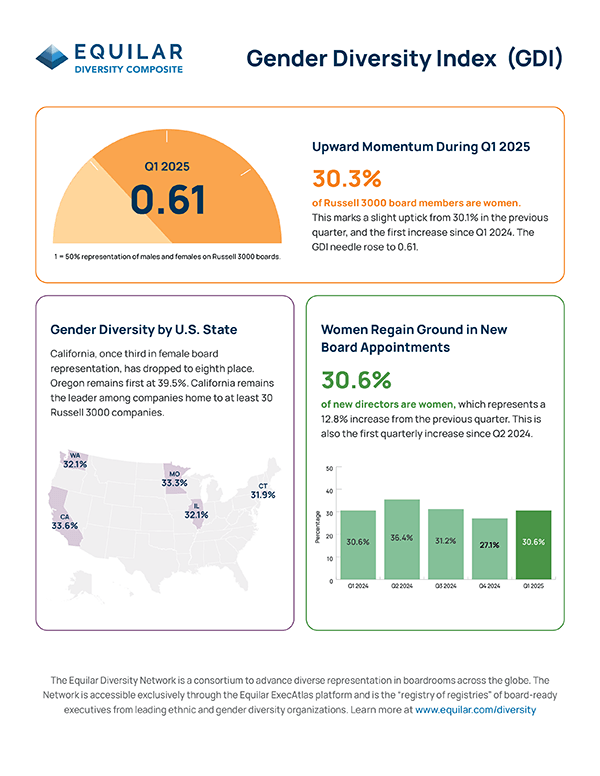Q1 2025 Equilar Gender Diversity Index
New female directors make up 30.6% of recent appointments
May 16, 2025
Joyce Chen
The pace of women joining boards is starting to pick up, and the Equilar Gender Diversity Index (GDI) reached a study-high of 0.61, where 1.0 signifies gender parity. Additionally, 185 boards have reached gender parity, up from 164 a year ago.

Female representation on Russell 3000 boards has increased to 30.3% in Q1 2025 from the 30.1% observed in the preceding three quarters. When compared to the first quarter of the previous year, when female directors held 29.7% of board seats, the current data highlights a 2% increase. Female board representation has bounced back after a slowdown in recent quarters, which indicates there remains some level of commitment to enhancing gender diversity within the highest levels of corporate governance.
The Q1 2025 appointment data indicates a higher number of new female directors compcared to Q4 2024. Out of the 627 new directors who joined Russell 3000 boards in Q1 2025, 30.6% were women. In contrast, Q4 2024 witnessed the appointment of 398 new directors, where 27.1% were women. Interestingly, this positive trend in female appointments appears to be holding despite recent pushbacks on diversity, equity and inclusion (DEI), particularly those focused on gender diversity, stemming from political pressures. The data indicates that Russell 3000 boards are still prioritizing gender diversity when making board selections.
| Year |
New Directors Who are Women (Russell 3000) |
| Q1 2024 |
30.6 |
| Q2 2024 |
36.4 |
| Q3 2024 |
31.2 |
| Q4 2024 |
27.1 |
| Q1 2025 |
30.6 |
Despite the overall progress, the data also reveals that a small portion of Russell 3000 boards still lags in gender diversity. The rate at which all-male boards added women significantly decreased after Q4 2021. In Q4 2021, nearly 16% of companies with all-male boards added at least one woman. Since then, this rate has sharply declined and has generally ranged between 0% and 5%. Additionally, the number of all-male boards in the Russell 3000 has stagnated at around 60 to 70 since Q1 2022.
As of Q1 2025, 64 boards, representing 2.2% of all boards within the index, maintained all-male members with no female representation. Additionally, the prevalence of all-male boards has remained at around 2% of Russell 3000 boards since Q1 2022. While it is worth noting that all-male boards are not significantly increasing, the slow short-term progress suggests a lack of proactive measures for gender inclusion. However, a longer-term view reveals considerable progress: in Q1 2020, 7.1% of Russell 3000 boards were all-male, and in Q1 2017, this figure was significantly higher at 22.5%. The continued existence of all-male boards, even at a lower rate, underscores the necessity for greater efforts to achieve broader gender diversity.
Examining Diversity by State
California, historically home to the largest number of publicly traded companies among the 50 states with 469 companies in the Russell 3000, saw a shift in its diversity ranking. While California was once third in terms of female board representation, its ranking has seen a gradual decline, sitting in eighth place with 33.6% of board seats in the state occupied by women as of Q1 2025.
Conversely, Oregon remains in first place. The state has also seen an increase in the representation of women from the previous year, growing from 37.6% to 39.5%. However, it is important to note that Oregon’s leading percentage is based on 12 Russell 3000 companies. When comparing by company count, California still leads the way in representation. The full list of rankings for each state can be found in the table below.
The Q1 2025 Equilar Gender Diversity Index highlights the ongoing progress in enhancing gender diversity within boardrooms of Russell 3000 companies. While the data offers encouraging trends, such as a study-high in overall female board representation and the continued rise of the GDI, it also highlights where progress has plateaued, especially among companies that have no female representation. As the year continues, board diversity trends are subject to change and will be worth monitoring closely.
About Equilar Gender Diversity Index
The Equilar GDI reflects changes on Russell 3000 boards on a quarterly basis as cited in 8-K filings to the SEC. Most indices that track information about board diversity do so annually or even less frequently, and typically with a smaller sample size, sometimes looking back more than a full year by the time the information is published. The Equilar GDI aims to capture the influence of the increasing calls for diversity from investors and other stakeholders in real time.
The Equilar GDI is powered by Equilar ExecAtlas, a database of board members and executives. ExecAtlas includes exclusive features that show how board members and companies are connected to each other, as well as the Equilar Diversity Network (EDN), a “registry of registries” of board-ready executives from leading ethnic and gender diversity partnerships, organizations, and publications.
Contact

Joyce Chen
Associate Editor at Equilar
Joyce Chen, Associate Editor at Equilar, authored this post. Equilar Researchers Sehee Han, Jeremy Ho, Grace Huang, Gabriel Klewin, Olivia Simon, Yuiko Shimizo, Amory Tong and Tina Tong contributed data and analysis. Please contact Amit Batish, Senior Director of Content & Communications, at abatish@equilar.com for questions about the data featured in this post.
 Solutions
Solutions












